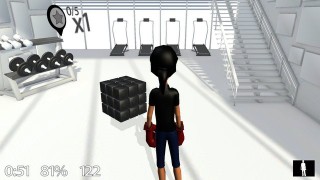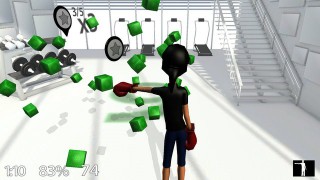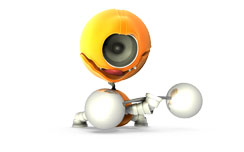
 |
 |
 |
BRIEF DESCRIPTION
The game Gym places the patient in a virtual gym. Unlike in the previous modules, the patient does not see the mirror image of her-/himself in the screen, but a 3-dimensional virtual person designed to reflect the patient’s movements and gestures. The patient sees the virtual person from behind, so the image presents non-mirror reflection of the patient’s movements. The patient’s aim in this module is to hit, kick, or box the cubes that appear in the screen. The arrangement and the speed with which the cubes appear and disappear, as well as the dynamics of the whole game are subject to modification. The module accurately records and demonstrates the difference in the speed of movement between the left and right side of the body. The exercise does not require that the patient be set in a certain position with respect to the camera – the system adjusts to the patient’s position and places the targets symmetrically with respect to this position.
RECOMMENDATIONS AND POSSIBILITIES
The module serves to increase and examine the speed of reaction time, as well as to practice the bilateral movements during which the upper and lower limbs cross the centerline of the body. Additionally, the module involves making decisions with respect to negative stimuli and gives opportunity to exercise rhythmicity and to perform movements in a limited amount of time.
PATIENT REQUIREMENTS
The exercise parameters are subject to modification, which eliminates any limitations with respect to the patients’ needs.
TASKS
The main task is to score points for breaking the cubes which appear in three colors: green, red, and grey. The green cubes are meant for hitting and by breaking them the patient scores some points. The red cubes are not meant for hitting, that is, the patient should not hit them. The gray cubes can be hit by the patient but by hitting them the patient does not score any points – a grey cube can be treated as a green cube which has expired. Besides scoring the points for hitting the green cubes, the patient is rewarded for her/his appropriate reactions to all types of cubes. For reacting correctly several times in a row the points that the patient scores from the given moment are multiplied until the patient hits a red or grey cube. Then the multiplying factor is again reduced to 1. The cubes can be arranged in various positions so that the patient can hit them by moving to the side as well as to the front/back. The therapist can modify the exercise also with respect to the part of the body used by the patient and, for instance, make the patient use only one hand, legs instead of hands, or all limbs together to hit the cubes.
DIFFICULTY LEVELS
The game has 3 levels of dynamics to choose from, which affects the speed of the objects’ appearing and disappearing from the screen. It is also possible to modify the distance between the objects and the patient, as well as to adjust the area in which the objects appear either to the hands or to the legs of the patient. With progress, the therapist should use obstacles (the red cubes) and the advanced system of counting points in the patient’s training.
DATA AND REPORTS
The system saves data concerning the level of correctness, activity, and the speed of both the performed movements and incorrect reactions to negative stimuli.
HINTS AND TIPS
When the activities in the exercise are not limited to movements in the lateral plane, the therapist can make the exercise easier by suspending the patient’s hands on elastic cord hanging from the ceiling, or harder by asking the patient to perform the exercise using weights or dumb-bells.
More information


This is a modern approach to rehabilitation, which is fun for the patient. This form of a session, from the psychological point of view, brings many positive aspects, which result in stronger effects - desired in terms of improving the functioning of the people undergoing the rehabilitation. Find more Kinect Rehabilitation




